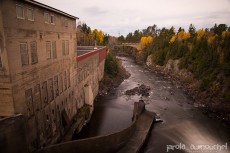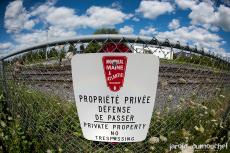The place is big, very big. While the building is nearly 200,000 square feet, the site, meanwhile, is over than 430,000 square feet in an agricultural area of Saint-Jean-sur-Richelieu. For those interested, the site is for sale and the current...
The abandoned power plant
Pretty from the outside, ugly from the inside
Its architecture reminds of the old ramparts of Quebec instead the image to which one is accustomed to power plants.
Yet it is part of this canadian architectural style of the late nineteenth and much of the twentieth century. One of the few industrial buildings inspired by the architectural wave, by cons. Built in a little less than a year in 1899, the building was divided into three parts: the machinery was in the central portion; left were the quarters of the workers and warehouse was located to the right. Today, the three divisions remain, but while the central part has been emptied of its contents, the two wings have been converted into apartments. The rooms are small and the stairs are narrow and the floor could collapse at any time under the weight of visitors.
Historic monument since 2007, the building now belongs to the city who wishes to promote this building with a project to be defined. Although it does not seem to have any water infiltration, its structure is not in a good shape. Many bricks threaten to collapse in several places, the floors are dangerously wavy and many stilts have been added to the outer gallery to prevent it from sinking into the small marsh.
Real vestige of a era when electricity had not yet been nationalized, it is one of the last four hydroelectric plants that remain among the 87 built in Quebec before 1900. With the electricity produced, the plant was able to light and operate the different locks, swing bridges and weirs. The operation of the canal was therefore maximized and allow workers to manage the seaway during day and night.
The plant ceased operations in 1959.
Related content
For the region, it is a vestige of an industrial era that is now over. Whereas in the past, the factory gave a salary to nearly a hundred employees, the complex is now padlocked and deserted, although monitored by about twenty surveillance...
From the outside, there is no indication that the plant is abandoned. No window is doomed and there is no "for sale" sign. Even the structure of the building is still in very good condition. I myself had doubts when I heard about it for the first...
Well, to be honest, the railway Montreal Maine & Atlantic Railway site we visited is not a real urbex site. At least not yet. But between you and me, it should not take long.
A story that everybody hear aboutWhether you live in...




















